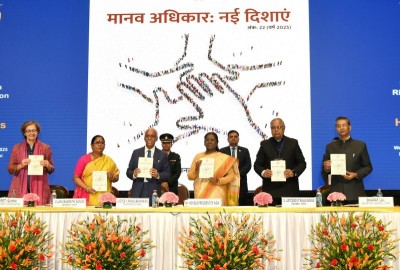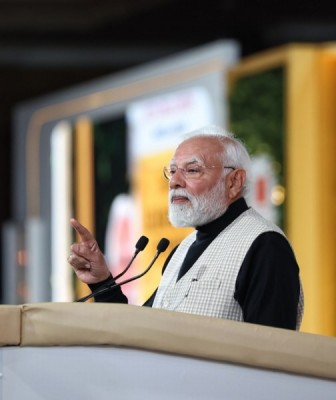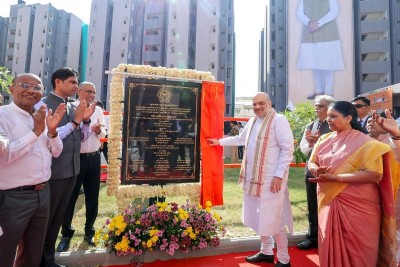
Chhattisgarh: Bijapur: 'Revolution' Interrupted
On April 27, 2018, eight Communist Party of India-Maoist (CPI-Maoist) cadres, including six female cadres, were killed in an encounter with Security Forces (SFs) in the deep forests under Ilmidi Police Station limits in Bijapur District, Chhattisgarh. The Police recovered one Self Loading Rifle (SLR), one .303 rifle, four 12-bore guns, four Single Barrel Breach Loading (SBBL) guns, one .315 bore rifle, one revolver, live cartridges, three hand grenades, six rocket launchers, four pairs of olive green dresses and Naxal [Left Wing Extremist (LWE)] literature from the encounter spot. According to Special Director General (anti-Naxal Operations), D. M. Awasthi, the killed CPI-Maoist cadres were active in the Usoor and Basaguda area of Bijapur District.
On April 5, 2018, a CPI-Maoist cadre, identified as Mangu Oyam, was killed in an encounter with SFs in a forest near Itampara village in Bijapur District. After the operation the Police recovered one .315 bore rifle along with 10 live rounds, one INSAS (Indian Small Arms System) assault rifle magazine with four live rounds, an improvised explosive device (IED) weighing two kilograms, a couple of detonators, and other material from the encounter site.
On March 1, 2018, at least 10 CPI-Maoist cadres, including six women, and one trooper were killed in an encounter near Pujarikanker in Bijapur District. The Police also recovered one AK-47 rifle, one SLR, two single bore rifles, five INSAS assault rifles, one .303 rifle, one pistol, three claymore mines, two solar plates, seven kit bags, a Sony radio, empty cartridges, live ammunition of different calibres, Naxal literature and cash amounting to INR 41,000 from the encounter site.
According to partial data collated by the South Asia Terrorism Portal (SATP), at least 22 Maoists have been killed in Bijapur District thus far in 2018 (all data till May 6, 2018). These Maoists have been killed in five incidents. During the corresponding period in 2017, seven Maoists had been killed in six incidents. A total of 18 Maoists were killed in the District, in 14 incidents through 2017. There were at least 33 Maoist fatalities in 17 incidents in 2016; 17 in nine incidents in 2015; 20 in 12 incidents in 2014; 11 in seven incidents in 2013; 27 in seven incidents in 2012; 14 in seven incidents in 2011; and 31 in eight incidents in 2010. The highest number of Maoist fatalities was recorded in 2008 at 44, while a low of 10 in this category was registered in 2007, after May 11. The District of Bijapur was carved out from the erstwhile Dantewada District on May 11, 2007. The lowest number of fatalities recorded in a full year after the creation of Bijapur in this category was 11 in 2013. A total of 289 Maoists have been neutralised since the creation of the District.
In 2018, out of 27 Districts in the State, only four – Bijapur, Dantewada, Rajnandgaon and Sukma – have recorded Maoist fatalities. Bijapur headed the list, with 22 such fatalities; followed by Sukma with nine, Rajnandgaon with three, and Dantewada with one. Additionally, out of 12 Districts across four States from where Maoist fatalities have been recorded in the current year, Bijapur was the second highest, with 22 fatalities; preceded by Gadchiroli (Maharashtra) with 48 Maoist fatalities. Significantly, Bijapur shares a border with Gadchiroli.
Further, combing operations also resulted in the arrest of 17 Maoists in Bijapur District in 2018, according to SATP data. During the corresponding period in 2017, 18 Maoists had been arrested, and a total of 68 through 2017. SF pressure also led to the surrender of six Maoists in 2018. During the corresponding period in 2017, five Maoists had surrendered, and a total of 11 through 2017.
However, in the face-off with the Maoists, SFs have also recorded a loss of at least eight of their personnel in Bijapur in the current year (data till May 6, 2018). During the corresponding period in 2017, four SF personnel had lost their lives, and a total of seven through 2017. Thus, the Maoists also have some ‘successes’ in the current year.
Meanwhile, civilian fatalities, a crucial index of the security situation in an area, which had been declining since 2014, and had come to their lowest in 2017, at three, has already reached five in the current year.
Indeed, in a media interview on April 17, 2018, Chief Minister (CM) Raman Singh conceded that Left-Wing Extremists still retain dominance in "15-20 per cent areas" in just two Districts – Bijapur and Sukma.
An overview of fatalities since Bijapur’s creation on May 11, 2007, shows that the District has registered at least 606 Maoist-linked fatalities, including 289 Maoists, 156 SF personnel and 161 civilians, roughly 26.37 per cent of the total of 2,298 fatalities, including 853 Maoists, 892 SF personnel and 553 civilians, recorded in the State during this period (data till May 6, 2018). It is significant that Chhattisgarh, which remains the hotbed of a significantly weakened Maoist insurgency, has alone contributed around 37.23 per cent of total Maoist-linked fatalities across the country over the corresponding period (May 11, 2007 – to May 6, 2018). The total number of fatalities across India during this period was 6,171 (2,511 civilians, 1,584 SF personnel and 2,076 Maoists), out of which Chhattisgarh accounted for 2,298 (553 civilians, 892 SF personnel and 853 Maoists). In the current year, with 87 fatalities (22 civilians, 30 SF personnel and 35 Maoists), 47.54 per cent of the total of 183 fatalities (47 civilians, 33 SF personnel and 103 Maoists) across the country in 2018; the State continues to maintain its unfortunate primacy.
The latest figures provided by the Union Ministry of Home Affairs (UMHA) indicate that 804 of the 908 LWE-linked incidents reported in 2017 across the country, took place in 35 Districts (88.55 per cent). Incidentally, Bijapur District with 60 incidents was ranked third among the worst affected; preceded by Gadchiroli District in Maharashtra with 68 incidents and the Sukma District of Chhattisgarh with the highest number, at 102. Bijapur shares borders with both Gadchiroli and Sukma.
Falling under the formidable Abujhmad region and the troubled Bastar Division, which still remain the primary challenge for the State, Bijapur, has a vast ‘geo-strategic importance’ for the Maoists. Sharing its boundaries with the Maoist-afflicted Narayanpur District (Chhattisgarh) to the North; Bastar District (Chhattisgarh) to the North-east; Dantewada District (Chhattisgarh) to the east; Sukma District (Chhattisgarh) to the South-east; Karimnagar, Warangal and Khammam Districts of Telangana on the south; and Gadchiroli District of Maharashtra on the West, makes it an ideal ground for the extremists. Unsurprisingly, in recent twin encounters on April 22-23, 2018, at least 40 Maoists were killed in Gadchiroli District, which was followed by the April 27, 2018, incident in which eight Maoists were eliminated in Bijapur.
The NITI Aayog on March 28, 2018, launched the baseline ranking for the ‘Aspirational Districts’ based on published data of 49 indicators (81 data points) across five developmental areas of Health and Nutrition, Education, Agriculture and Water Resources, Financial Inclusion and Skill Development, and Basic Infrastructure. Bijapur is among the 115 identified backwards Districts. Coincidentally, according to the “District Development and Diversity Index Report for India and Major States,” a joint survey conducted by the US-India Policy Institute (USIPI) and the Centre for Research and Debates in Development Policy (CRDDP), New Delhi, which included 599 Districts across India within its purview, Bijapur was ranked 372nd, i.e., among the relatively deprived Districts. The report released on January 29, 2015, took composite development — measured in terms of economic development and indices of health, education and material well-being – into consideration.
On April 8, 2018, Chief Minister Raman Singh admitting the reality that there are many backward Districts in Chhattisgarh, including Bijapur, Dantewada, and Sukma, observed,
Naxalism can only be countered by development. Wherever we are constructing roads and working on development, the Maoists are losing their foothold. Now, we have reached very close and are moving ahead in an important direction to root out the menace.
He also claimed that "frustrated Maoists" are losing their footholds due to the joint actions of the State and Central Governments, which have put the State on the path of development by building roads, schools and hospitals in remote and inaccessible areas that were earlier hotbeds of Maoist activity.
Meanwhile, laying out plans for various development works during his visit to Bijapur on April 14, 2018, Prime Minister Narendra Modi launched the first Health & Wellness Centre under the new healthcare system, the Ayushman Bharat Yojana (Blessed India Plan), at a tribal habitat, Jangala, in the District. He also rolled out the Van Dhan Yojana (Forest Wealth Plan) which aimed to train and empower the tribals in collecting and processing minor forest produce. The Prime Minister also inaugurated several development projects, including a new rail line, internet services, a dialysis centre at Bijapur District Hospital, as well as roads and bridges in the District.
The Maoists are facing a severe existential threat in their ‘core areas’, including Bijapur, though they retain the wherewithal to carry out surprise attacks targeting SFs. Past operational successes and a sustained developmental thrust have, however, weakened the movement drastically, and focused efforts by SFs and other State agencies are now in a position to transform past gains into an enduring peace.
Support Our Journalism
We cannot do without you.. your contribution supports unbiased journalism
IBNS is not driven by any ism- not wokeism, not racism, not skewed secularism, not hyper right-wing or left liberal ideals, nor by any hardline religious beliefs or hyper nationalism. We want to serve you good old objective news, as they are. We do not judge or preach. We let people decide for themselves. We only try to present factual and well-sourced news.







